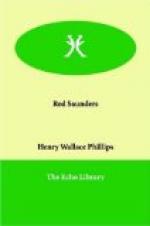When the Chinook Struck Fairfield
I
Miss Mattie sat on her little front porch, facing the setting sun. Across the road, now ankle deep in June dust, was the wreck of the Peters place: back-broken roof, crumbling chimneys, shutters hanging down like broken wings, the old house had the pathetic appeal of ship-wrecked gentility. A house without people in it, even when it is in repair, is as forlorn as a dog who has lost his master.
Up the road were more houses of the nondescript village pattern, made neither for comfort nor looks. God knows why they built such houses—perhaps it was in accordance with the old Puritan idea that any kind of physical perfection is blasphemy. Some of these were kept in paint and window glass, but there were enough poor relations to spoil the effect.
Down the road, between the arches of the weeping willows, came first the brook, with the stone bridge—this broken as to coping and threadbare in general—then on the hither side of the way some three or four neighbour’s houses, and opposite, the blacksmith’s shop and post-office, the latter, of course, in a store, where you could buy anything from stale groceries to shingles.
In short, Fairfield was an Eastern village whose cause had departed. A community drained of the male principle, leaving only a few queer men, the blacksmith, and some halfling boys, to give tone to the background of dozens of old maids.
An unsympathetic stranger would have felt that nothing was left to the Fairfieldians but memory, and the sooner they lost that, the better.
Take a wineglassful of raspberry vinegar, two tablespoonsful of sugar, half a cup each of boneset and rhubarb, a good full cup of the milk of human kindness, dilute in a gallon of water, and you have the flavor of Fairfield. There was just enough of each ingredient to spoil the taste of all the rest.
Miss Mattie rested her elbow on the railing, her chin in her hand, and gazed thoughtfully about her. As a matter of fact, she was the most inspiring thing in view. At a distance of fifty yards she was still a tall, slender girl. Her body retained the habit, as well as the lines of youth; a trick of gliding into unexpected, pleasing attitudes, which would have been awkward but for the suppleness of limb to which they testified, and the unconsciousness and ease of their irregularity.
Her face was a child’s face in the ennobling sense of the word. The record of the years written upon it seemed a masquerade—the face of a clear-eyed girl of fourteen made up to represent her own aunt at a fancy dress party. A face drawn a trifle fine, a little ascetic, but balanced by the humour of the large, shapely mouth, and really beautiful in bone and contour. The beauty of mignonette, and doves, and gentle things.
You could see that she was thirty-five, in the blatant candor of noon, but now, blushed with the pink of the setting sun, she was still in the days of the fairy prince.




